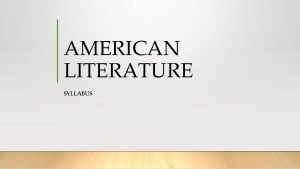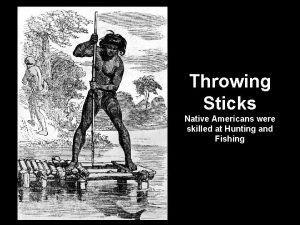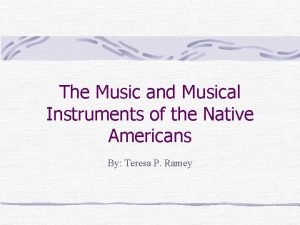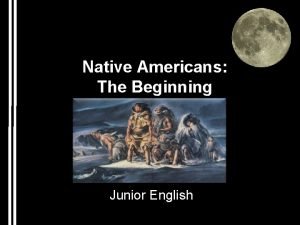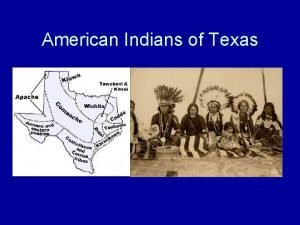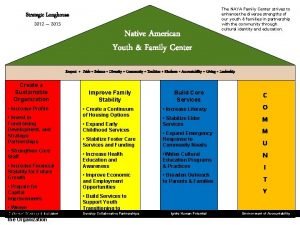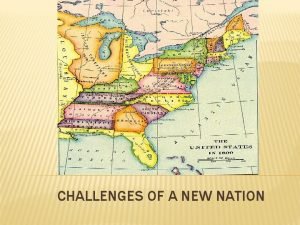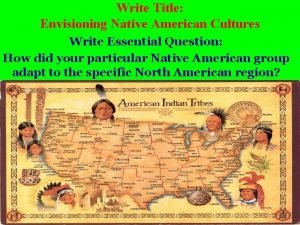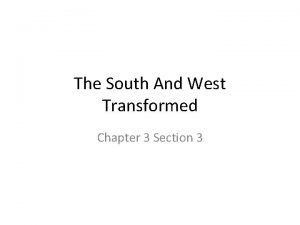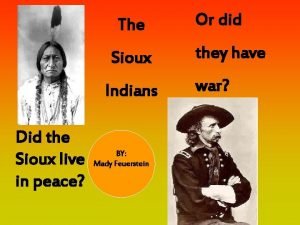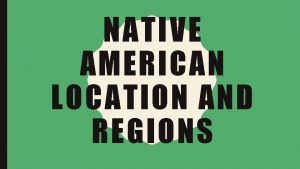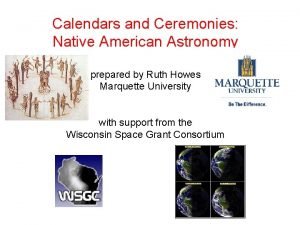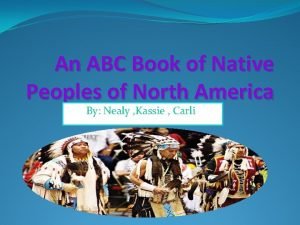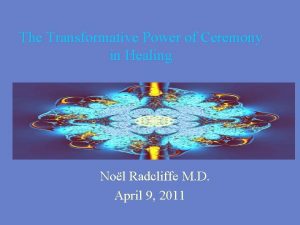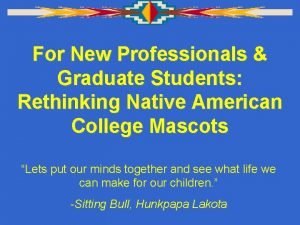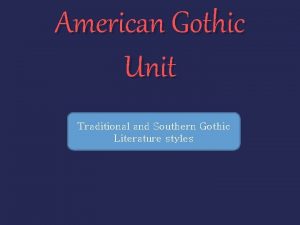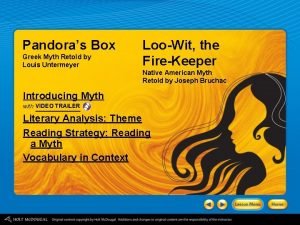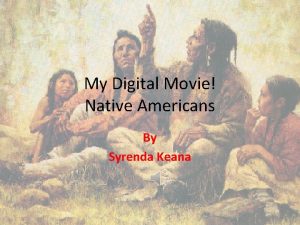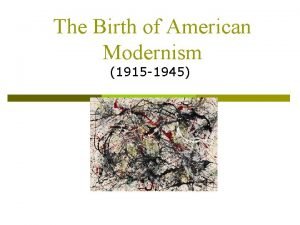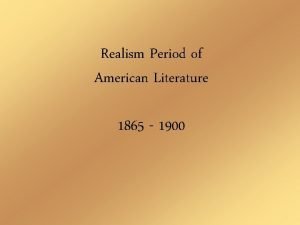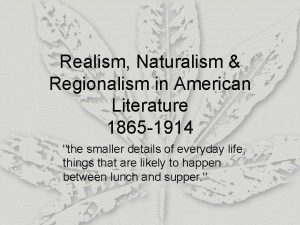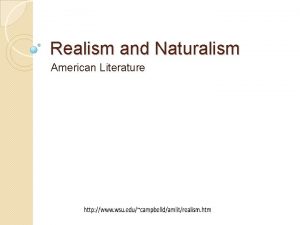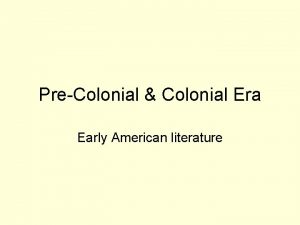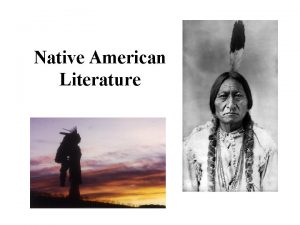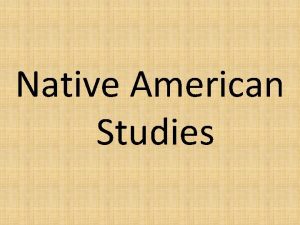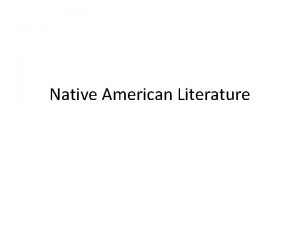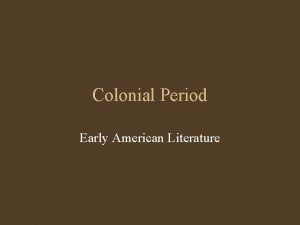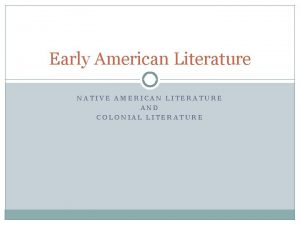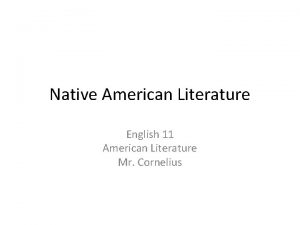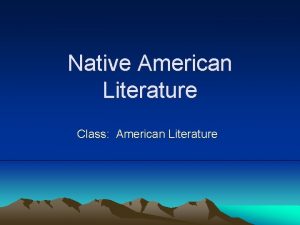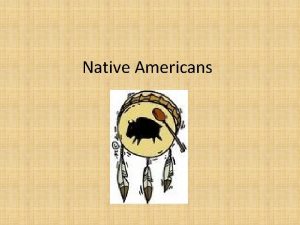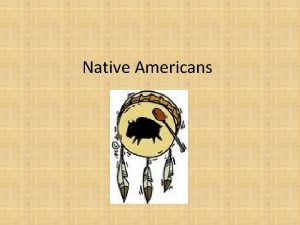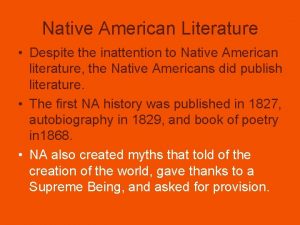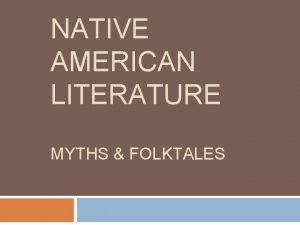Development of American Literature I PreColonial Native American





































- Slides: 37

Development of American Literature

I. Pre-Colonial Native American Lit. Characteristics: • Oral Traditions—stories, poems, and songs told by word of mouth • Conveys values, concerns, history, and culture • Reverence for nature • Often features immortal beings • Simple, concise language • Origin Myths—typically explain the beginning of the world and human life. Also explain: • Customs, institutions, religious rites • Natural landmarks (mountain) Tusks and Tradebeads -- Joanne Swanson • Events beyond people’s control

II. Narrative Accounts • Stories of real-life events • Explains events and experiences • Types of narratives: • Exploration Narrative—firsthand accounts of explorers travels and discoveries • Provides details of what they observed • Provided information to back in Europe • Slave Narratives—account of life as a slave often written to expose horrors of human bondage people the

III. Puritan Literature Beliefs: • Human beings exist for the glory of God • The Bible is the sole expression of God’s will • Predestination—God has already decided who will achieve salvation (go to heaven) and who will not • Hard-work and selfdiscipline (the Puritan Ethic)

III. Puritan Literature Jonathon Edwards -Puritan theologian, preacher, and philosopher. -Preaching aimed to “shake the faith of unrepentant sinners. ” -Enrolled in Yale at age 13. -Widely considered most influential writer before Benjamin Franklin. -Died of smallpox shortly after becoming president of what is now Princeton University.

III. Puritan Literature Purpose of Writing: provide spiritual insight and instruction Typical Writings: • Theological Studies • Hymns • Histories • Biographies • Autobiographies Personal writing (journal and diary) was for serious self-examination Fiction and Drama were considered sinful and therefore were not produced

IV. Revolutionary War Literature 1750 -1800 The Age of Reason *AKA The Enlightenment People Valued… • Reason, rationality, human intellect, logic • Scientific Method • Order, concentration, good taste, accuracy, correctness, • Restrained emotion • Self-control & self discipline

IV. Revolutionary War Literature • While Puritans wrote private soul-searching reflections, authors of the revolutionary period wrote public works (newspaper article, pamphlets, speeches, government documents). • Most of the writing from this period is POLITICAL.

IV. Revolutionary War Literature • At this point in the development of American literature there were no important novels or plays, and the short story hadn’t been invented. • By the close of this period, America was on the verge of a literary awakening.

IV. Romanticism: 1800 -1870 ØThese are NOT love stories!!! • Before 1800 very few people read American works • When peace was declared after the Revolution and a stable government was formed, there was an explosion of literary development • The primary theme: the quest of the individual to define him- or herself.

IV. Romanticism: 1800 -1870 Characteristics of Romanticism: Remember, it’s not necessarily about love! • Reacted AGAINST the ENLIGHTENMENT (restrained emotions, reason, logic) • Values EMOTION over reason • Emphasized the INDIVIDUAL & individual experiences • Places importance on the role of NATURE • Develops the narrative STORY—emphasis on PLOT • Uses SYMBOLS • Interested in the SUPERNATURAL (ghosts, spirits, the beyond)

IV. Romanticism: 1800 -1870 Poetry was widely read by Americans at this time • Fireside Poets: group of four extremely popular poets read in most American homes in the evening by the “fireside” or by students in the school house. The group included: • Henry Wadsworth Longfellow • John Greenleaf Whittier • James Russell Lowell • Oliver Wendell Holmes • Later, Walt Whitman and Emily Dickinson gained much fame for their poetry.

IV. Romanticism: 1800 -1870 Transcendentalism • American variation of romanticism • Values spiritual over material success • Intense individualism • Idealistic, Optimistic, believed in good • Self-reliance • Believed in living close to nature • Emphasized spiritual living (not religion) • Spiritual connection between people and nature • By attending to one’s innermost thoughts and feelings, one could glimpse the great spirit of the universe – the “Over-Soul”

IV. Romanticism: 1800 -1870 Anti-Transcendentalism • Focused on the limitations and potential destructiveness of the human spirit rather than on its possibilities. • Works dealt with themes of guilt, sin, betrayal, and darkness • pessimistic attitude • focused on man's uncertainty and limited potential in the universe • viewed nature as vast and incomprehensible, a reflection of the struggle between good and evil • felt humans were depraved and had to struggle for goodness • believed in a higher authority and that nature is ultimately the creation and possession of God – and can not be understood by humans.

V. Realism • The harsh reality of frontier life, coupled with reaction to the brutality of the civil war gave rise to this movement. • Enormous loss of life shattered the idealism fostered by the romantic period. • Writers focused on portraying “real life” as ordinary people lived it. • Attempted to show characters and events in an honest, objective, almost factual way.

V. Realism • Naturalism was a literary offshoot of realism • Still depicted real people in real situations • Believed that forces larger than the individual—nature, fate, heredity—shaped individual destiny

V. Realism l Regionalism—writers attempt to depict and analyze the distinctive and unique qualities of a geographical area and its people JACK LONDON BRET HART Alaska West—considered and Yukon father of regionalism MARK TWAIN KATE CHOPIN Mississippi River Louisiana Bayou Mining Camps of West Woman’s focus

Where they wrote about

V. Realism l Local Color – An aspect of regionalism – Highlights characters and details unique to a specific area – Captures the physical environment, as well as the mood of a time and place – Includes the way in which people talk and how they think

MODERNISM (1914 – 1940) Learning Target: I can summarize the tenants of modernism

What is Modernism? l Modernism reflects a loss of faith in traditional values and beliefs, including the American Dream. – Artistic/literary movement – Post World-War One – Pessimistic picture of culture in disarray – Modern poets goal = rid poetry of 19 th century prettiness & sentimentality – Rejected 19 th century optimism

The WORLD AS A WASTELAND

WORLD AS A WASTELAND Before WWI

WORLD AS A WASTELAND After WWI

WORLD AS A WASTELAND Before WWI

WORLD AS A WASTELAND After WWI

Q: What are some factors that led people during this time period to lose faith in the American Dream? A: -World War I & disillusionment, -Increase in industrialization, -Unfair labor practices, -Excessive drinking

Characteristics of Modernism 1. instability 2. futility

3. pessimism

4. chaos 5. Loss of faith

6. Collapse of “Morality” 1920: 1910: VS. Prohibition, “flappers, ” more open about sexuality, drug-use

7. Disillusionment: a feeling of disappointment resulting from the discovery that something is not as good as one believed it to be

Characteristics of Modern Literature New experiments with form and technique in both poetry and prose l A new kind of hero who is flawed and disillusioned yet honorable and courageous l Questioning of traditional beliefs and social structures l

Introduction: “The Second Coming” BY: William Butler Yeats 1919 After reading this poem, answer the following questions. l Then SOAPSTone the poem: l – How is this a good example of modern poetry? – What kind of world did Yeats propose that we were entering when he wrote this poem? – How accurate was his prophecy for the future? – SOAPSTone

MODERNISM REVIEW and connection to The Great Gatsby Learning Targets: • I can summarize the tenants of modernism • I can explain how an author’s choice contributes to overall meaning

What are the seven Characteristics of Modernism? 1. instability 2. futility 3. pessimism 4. chaos 5. Loss of faith 6. Collapse of “Morality” 7. Disillusionment

DIRECTIONS: In the box to the right of the picture, write down five details that you notice about the picture below (what does image include in the foreground, background? What colors are used? Is it inviting or uninviting? etc).
 Pueblos precolombinos de honduras
Pueblos precolombinos de honduras Periods of american literature
Periods of american literature Native american writing
Native american writing Native american literature syllabus
Native american literature syllabus Native american throwing stick
Native american throwing stick Native american musical instruments
Native american musical instruments How long have native american been living in america
How long have native american been living in america Native american religious beliefs
Native american religious beliefs Medicine wheel color
Medicine wheel color Native american dwellings
Native american dwellings A famous swashbuckling trio of old
A famous swashbuckling trio of old Native american youth and family center
Native american youth and family center Native connections housing
Native connections housing Native american important facts
Native american important facts Native american tribes
Native american tribes What three circumstances hurt native americans
What three circumstances hurt native americans Where sioux lived
Where sioux lived Native american skyscraper workers
Native american skyscraper workers Native american tribes in the united states
Native american tribes in the united states Native american cultural areas
Native american cultural areas Native american calendars
Native american calendars Native american abc book
Native american abc book Native american letting go ceremony
Native american letting go ceremony Native american morals and values
Native american morals and values Belief me
Belief me Indian burial grounds candy bar
Indian burial grounds candy bar American gothic literature characteristics
American gothic literature characteristics What is the theme of pandora's box
What is the theme of pandora's box Native american writing
Native american writing Keana inu
Keana inu Native american healing prayers for the sick
Native american healing prayers for the sick Android native game development
Android native game development Romantic period american literature
Romantic period american literature American modernism characteristics
American modernism characteristics Realism literature period
Realism literature period Regionalism literature
Regionalism literature Realism in american literature
Realism in american literature Realism and naturalism in american literature
Realism and naturalism in american literature



